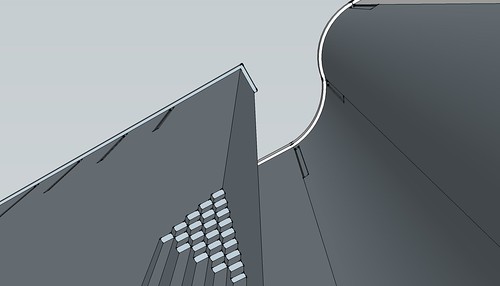Ok, so now we're back on track, I will try and give as brief a possible overview I've undertaken since the last post, and where my practice is going.
St. Bride's and Magnificent Modernism
The modelling of St. Bride's coming along nicely, albeit slower than I would like. I'm spending time trying to capture the sculptural details which were (in my opinion) of critical importance to Gillespie, Kidd & Coia's visual language they developed for what I like to call The New Catholic Church. I'm moving towards projection tests of the model by the end of the month, which give me a feel for how I want to take the concept of Virtual Modernism forward. The delay has primarily been caused by a new focus of work I intend to undertake this semester, in short, the understanding of the modern social interactions present day users have with modernist structures.
Space Syntax
One thing my previous work lacked, was the social impact of modernist buildings on those who used them (who I will rather cleverly refer to as "users"). This was in part due to my regard of the social issues surrounding modernism giving birth to the stigmatism that often surrounds the movement, but it also was not knowing how to address the sticky goo that is human interaction with space. Space syntax may provide the answer to my woes. Understanding how a space is currently used, will allow me to compare and contrast the architects vision against the reality. Obviously the modernist utopia did not come to fruition, but there are still tangible ideas within modernist spaces that are often overlooked when the movement is shrugged off as a "failure".
I'm still in my very early days of research into space syntax, but I have been afforded the opportunity of a placement on the SerenA Project, based in the VRC, at Dundee Contemporary Arts. In effect I intend to use the DCA as test-bed for the theories of space syntax, and attempt to visual the outcomes in a conceptual manner. Like with St. Bride's, I intend to create a work that enters into a conversation with the viewer. In the case of the DCA, the viewer of any outcome may also be the user of the space, and as such the connection between the work and viewer becomes more profound.
Space syntax is a very well research area, and I'm not attempting to bring new theory, but instead, at the very least, enhance the visualisation possibilities of current space syntax visualisation. I would like to marry the ideas formulated from my concept of Virtual Modernism, and perhaps use more immersive installation based work to present space syntax data.
I'm equally fortunate (through involvement with SerenA) to have the opportunity to interact with Space Group, University College London (a leading voice in space syntax theory), who will no doubt will have a profound impact on my own artistic practice.
Now, I'm back on the blogging band wagon I intend more frequent updates with a greater focus on specifics. Right now, this is a general overview of where I am, and where I am going. No doubt over the coming weeks I will back-reference anything I've missed, and expand on anything I've not made clear.

No comments:
Post a Comment